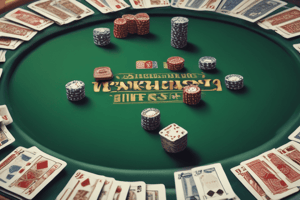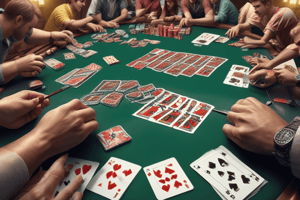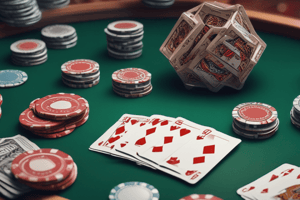Podcast
Questions and Answers
What must the Dealer do if a player is unwilling to provide the necessary items for verification?
What must the Dealer do if a player is unwilling to provide the necessary items for verification?
- Allow the player to continue playing without verification.
- Notify the player of the inability to make exceptions and call for a Floor Supervisor. (correct)
- Ask another player to verify on behalf of the unwilling player.
- Request the player to provide the items later during the tournament.
How are seat numbers assigned in the tournament?
How are seat numbers assigned in the tournament?
- Players choose their seat numbers.
- Seat numbers are assigned by the Dealer.
- Players can exchange seat numbers at any time.
- Seat numbers are assigned by a computerized random draw. (correct)
Why is it important for the Dealer to retain the DEALER COPY of the receipt?
Why is it important for the Dealer to retain the DEALER COPY of the receipt?
- To keep a record of their own transactions.
- To show proof of purchase to the players.
- To verify a player's attendance and seating. (correct)
- To give it to the player as a keepsake.
What should a Dealer do with the DEALER COPY of the receipt at the end of the table's closure?
What should a Dealer do with the DEALER COPY of the receipt at the end of the table's closure?
When can seat exchanges occur during the tournament?
When can seat exchanges occur during the tournament?
What action should a Dealer take if a player demands to change their assigned seat?
What action should a Dealer take if a player demands to change their assigned seat?
How should special accommodations for players with special needs be handled?
How should special accommodations for players with special needs be handled?
What should the Dealer do if a player is unwilling to provide the required items for verification?
What should the Dealer do if a player is unwilling to provide the required items for verification?
Why is it crucial for the Dealer to retain the DEALER COPY of the receipt?
Why is it crucial for the Dealer to retain the DEALER COPY of the receipt?
What should the Dealer do with the DEALER COPY of the receipt at the end of the table's closure?
What should the Dealer do with the DEALER COPY of the receipt at the end of the table's closure?
How are seat numbers assigned in the tournament?
How are seat numbers assigned in the tournament?
When can seat exchanges occur during the tournament?
When can seat exchanges occur during the tournament?
What action should a Dealer take if a player demands to change their assigned seat?
What action should a Dealer take if a player demands to change their assigned seat?
How are special accommodations handled for players with special needs in tournaments?
How are special accommodations handled for players with special needs in tournaments?
Which item must match according to verification procedures?
Which item must match according to verification procedures?
What should a Dealer do if the player is in the wrong room?
What should a Dealer do if the player is in the wrong room?
Flashcards are hidden until you start studying
Study Notes
Deck Introduction
- New decks must be spread face up, face down, and scrambled (washed)
- Dealer must check the completeness and consistency of each deck, front and back
- Used decks must be spread face down and scrambled before being dealt
Resetting the Deck
- Dealer should reset both decks during player breaks to verify the presence of all 52 cards without duplicates
- Decks should be reset with diamonds on the bottom, then clubs, then hearts, with spades being the top suit
- Each suit should be set with the King on the bottom, then Queen, Jack, etc., consecutively, with the Ace being the top card
Counting the Deck Stub
- Dealer must count the deck stub after the first hand dealt on each table
- Count should be completed after the final card has been delivered, while waiting for the players to complete their action
- If the Dealer does not count 52 cards, they should not bring this to the attention of the players
- Dealer should switch decks and call the Floor, then notify the Floor person that the cards are "sticky"
Shuffling
- WSOP procedure is "Shuffle - Shuffle - Box - Shuffle" (S.S.B.S)
- Cards must be boxed into four or more equal sections (at least three strips)
- Cards should be held low, flat, and level to the table surface, avoiding exposure
- During SSBS, if ante's are in play, look around, know where ante's are missing or where players need change
Cutting the Deck
- When the shuffle is complete, release the deck and place the cut card on the table directly in front of the deck
- Collect the antes, if applicable
- Use a system to collect ante's, such as seats 1, 2, 3, 4, 5 (left hand) then seats 10, 9, 8, 7, 6 (right hand)
- Cut the deck with one hand, square the deck using a corner pinch, then release the deck
Handling the Deck
- Deck should be held parallel to the table at all times
- Dealer should not roll the deck sideways or upside down for any reason
- Top of the deck should never be obscured from the view of any player
- Dealer should not cap or palm the deck
Burn Cards
- Before burning a card, dealer should lightly tap the table to let players know that the previous round has been completed
- Burn cards should be dropped straight down onto the table, at the top of the box, and then pushed under the chips at the "bottom of the pot"
- Burn cards should never be on the table unprotected; always use a chip from the pot to protect the burn cards
The Muck
- When a player folds their hand, the dealer must immediately muck the player's cards
- Mucked hand should never be lifted from the table surface
- Cards should be slid and integrated into the muck; non-retrievable
Dropping the Stub
- Dealer should drop the deck immediately after dealing the last card
- Deck should be dropped and spread above the top right corner of the table bank
- Top of the deck should be protected by the cut card and retrievable in case there has been an irregularity on the deal
Missed Blinds
- There are no missed blinds in tournaments
- If the player is absent from the table, the dealer will post the appropriate blind from the player's chips and bring it into the pot when the hand is mucked
Incoming Players
- A player being moved to a new table must begin play as soon as possible by assuming the position of that seat
- The only exception is that the player may not receive a hand in between the Small Blind and the Button
Showdown
- Dealer must read all hands exposed at Showdown "out loud" to the table
- Dealer should not touch a player's hand while reading the cards unless absolutely necessary
- Moving the cards around to put them in order (also known as "sautéing") is not acceptable
- If no players respond by revealing their cards when the dealer announces Showdown, the last aggressive bettor is required to show his hand first
Dealer Instructions to Players
- Give clear, concise directions to the players at the table
- Use standard directions that are understood by all players, such as "Action", "Bet", "Raise", "Showdown", "Hands Please", "Discards Please", etc.
- Avoid using slang and unclear directions
Set-Ups
- When a new setup arrives at the table, the front and back of both decks must be verified
- There should never be more than two decks of cards on a poker table at one time
Raise
- Dealer will not clear the betting perimeter to "show the raise" during a betting round unless requested by the player whose action is pending
- Dealer should announce "Raise" then direct the action to the appropriate player position
Blind Check
- A "blind check" is acceptable in tournament play from the player with first action
- Direct the action to the proper player as appropriate
One Dealer to a Table
- During the push, the incoming dealer should not involve themselves in the completion of the hand in progress
- Only one dealer should be sitting at any table at any time
Direct the Action
- Direct the "action" not the "bets"
- Do not reach out to stack or count a player's bet unless requested by the player whose action is pending
- Should a player ask "HOW MUCH", the dealer's answer should be "Action is in Seat [number], I will be with you in turn"
Accurate Count of Chipstack
- Players are entitled to a reasonable estimation of an opponent's chip stack
- Players may request a more precise count if facing an All-In bet
- The All-In player is not required to count their stack
- Should the player not wish to provide an accurate count, the dealer or tournament official will count the stack
Stacking Chips and Split Pots
- When splitting the pot, start stacking with the highest denomination chip towards the players and work towards the lowest denomination of chips
- Pot should be split "CLEAN"; that is, by not stacking any denomination on top of another denomination
- Main pot and all side pots will be split separately, never mixed together
Pot Split Procedure
- STEP 1: Pot with burn cards pushed under chips
- STEP 2: Begin to stack the chips after the last card has been delivered
- STEP 3: Stack the chips - "DO NOT" stack and split in the same procedure
- STEP 4: Pot split with "CLEAN STACKS"### Dealing Procedures
- Improper Split Pot: When stacking chips, ensure equal division among players; a "dirty stack" may appear unequal due to chip denominations.
- Odd Chip: In Stud games, the odd chip is given to the highest card by rank and suit; in Flop games, the high hand receives the odd chip.
Change and Tournament Tokes
- Change: Dealers should make change from bets on the table during collection; verbally inform players of "CHANGE COMING" to ensure they receive their change.
- Tournament Tokes: Dealers receive tokes (tips) in tournaments, which are shared among staff; dealers should not conceal tokes and must deposit them with a Tournament Official.
Official Language and Terminology
- Official Language: The official language of the World Series of Poker (WSOP) is English.
- Official Terminology: Use simple, unmistakable declarations like "bet," "call," "fold," and "check" to avoid confusion.
Table Protocol
- Card Placement: Burn cards are placed at the bottom of the pot; side pots are placed to the right of the board cards.
- Final Table Dealers: After the last hand, drop the deck, and watch for chip removal as "souvenirs."
Anticipation Game
- Practice Anticipation: Practice reading boards and hands in games like Omaha Hi/Low 8 or Better and Razz to anticipate best high and low hands.
Multi-Table Tournament Procedures
- Setting Up: Dealers receive a down for setting up the table; they must be completely prepared before the tournament starts.
- Player Seating: Verify player information, including tournament receipt and ID, and seat players accurately.
- Dealer Button: The dealer button starts in the first live seat to the right of the dealer; in Heads-Up tournaments, the button is determined by a card draw.
Deck Introduction and Resetting
- New Decks: Spread face up, face down, and scramble (wash) new decks.
- Used Decks: Spread face down and scramble used decks before dealing.
- Resetting the Deck: During player breaks, reset decks to verify all 52 cards are present without duplicates.
- Counting the Deck Stub: Count the deck stub after the first hand and at least once during the down; notify the Floor if the count is incorrect.
Shuffling and Cutting the Deck
- Shuffling: Use the "Shuffle-Shuffle-Box-Shuffle" (S.S.B.S.) procedure.
- Cutting the Deck: Release the deck, place the cut card on the table, collect antes (if applicable), and cut the deck with one hand.
Handling the Deck
- Deck Position: Hold the deck parallel to the table, low, flat, and level, with the top of the deck visible to players.
- Burn Cards: Tap the table, burn a card, and push it under the chips at the bottom of the pot.
- The Muck: Immediately muck folded hands, sliding them into the muck without lifting or stacking.### Dealing Procedures for Tournaments and Live Action
General Guidelines
- Never drop the deck stub on the muck or mix the stub, burns, and muck prematurely.
- The dealer should read all hands exposed at showdown out loud to the table to prevent errors.
- Dealers should not touch a player's hand while reading the cards unless absolutely necessary.
Showdown Procedures
- If no players respond to the dealer's announcement of showdown, the last aggressive bettor is required to show their hand first.
- In flop/button games, the player in first acting position is required to show their hand first.
- In stud games, the player with the high board is required to show their hand first.
Blind Checks
- A "blind check" is acceptable in tournament play from the player with first action.
- The dealer should direct the action to the proper player as appropriate.
One Dealer to a Table
- During the push, the incoming dealer should not involve themselves in the completion of the hand in progress.
- Only one dealer should be sitting at any table.
Stacking Chips and Split Pots
- When splitting the pot, start with the highest denomination chip towards the players and work towards the lowest denomination.
- The pot should be split "clean" without stacking any denomination on top of another.
- Pay high, kill high; pay low, kill low to avoid stacking both splits at the same time.
Dealer Instructions to Players
- Give clear, concise directions to players at the table.
- Avoid using slang or unclear directions.
Counting Chips
- Players are entitled to a reasonable estimation of an opponent's chip stack.
- Players may request a more precise count if facing an all-in bet.
Tournament Tokes
- Tokes are shared between dealers, clerks, and cashiers.
- Do not conceal tokes in pocket, fanny pack, or other fashion.
Official Language and Terminology
- The official language for the World Series of Poker is English.
- Official terminology includes bet, call, fold, check, all-in, pot (in pot-limit only), and complete.
Change
- Change can be made from the bets on the table during collection once action is complete for the betting round.
- The dealer should make known to the player that "change is coming" and provide the change before leaving the table.
Studying That Suits You
Use AI to generate personalized quizzes and flashcards to suit your learning preferences.




